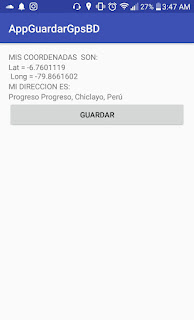Handler handler = new Handler();
public class MainActivity extends AppCompatActivity {
handler.post(sendData);
public class MainActivity extends AppCompatActivity {
TextView mensaje1;
TextView mensaje2;
Handler handler = new Handler();
@Override protected void onCreate(Bundle savedInstanceState) {
super.onCreate(savedInstanceState);
setContentView(R.layout.activity_main);
handler.post(sendData);
mensaje1 = (TextView) findViewById(R.id.mensaje_id);
mensaje2 = (TextView) findViewById(R.id.mensaje_id2);
botonGuardar.setOnClickListener(new View.OnClickListener() {
@Override
public void onClick(View v) {
new Insertar(MainActivity.this).execute();
}
});
Entonces ahora debemos borrar el onclick y enviar el método new Insertar(MainActivity.this).execute(); por medio de nuestro Handler y el código seria algo así:
protected void onDestroy() {
super.onDestroy();
handler.removeCallbacks(sendData);
}
private final Runnable sendData = new Runnable(){
public void run(){
try {
new Insertar(MainActivity.this).execute();
handler.postDelayed(this, 1000);
}
catch (Exception e) {
e.printStackTrace();
}
}
};
Y como gestionamos cada cuantos segundos, minutos u horas se enviara la dirección a nuestra BD, pues esta parte del código lo gestiona:
handler.postDelayed(this, 1000);
1000 = 1 segundo
2000 = 2 segundos
60000= 60 segundos
Y asi sucesivamente con eso ya estaria completa nuestra aplicacion a continuacion les dejo el codigo completo y armado:
public class MainActivity extends AppCompatActivity {
TextView mensaje1;
TextView mensaje2;
Handler handler = new Handler();
@Override
protected void onCreate(Bundle savedInstanceState) {
super.onCreate(savedInstanceState);
setContentView(R.layout.activity_main);
handler.post(sendData);
mensaje1 = (TextView) findViewById(R.id.mensaje_id);
mensaje2 = (TextView) findViewById(R.id.mensaje_id2);
if (ActivityCompat.checkSelfPermission(this, Manifest.permission.ACCESS_FINE_LOCATION) != PackageManager.PERMISSION_GRANTED && ActivityCompat.checkSelfPermission(this, Manifest.permission.ACCESS_COARSE_LOCATION) != PackageManager.PERMISSION_GRANTED) {
ActivityCompat.requestPermissions(this, new String[]{Manifest.permission.ACCESS_FINE_LOCATION,}, 1000);
} else {
locationStart();
}
}
//Enviamos de forma automatica la direcion
@Override
protected void onDestroy() {
super.onDestroy();
handler.removeCallbacks(sendData);
}
private final Runnable sendData = new Runnable(){
public void run(){
try {
new Insertar(MainActivity.this).execute();
handler.postDelayed(this, 1000);
}
catch (Exception e) {
e.printStackTrace();
}
}
};
//Insertamos los datos a nuestra webService
private boolean insertar(){
HttpClient httpClient;
List<NameValuePair> nameValuePairs;
HttpPost httpPost;
httpClient = new DefaultHttpClient();
httpPost = new HttpPost("http://192.168.8.118/gpsbd/insertar.php");//url del servidor
//empezamos añadir nuestros datos
nameValuePairs = new ArrayList<NameValuePair>(4);
nameValuePairs.add(new BasicNameValuePair("coordenadas",mensaje1.getText().toString().trim()));
nameValuePairs.add(new BasicNameValuePair("direccion",mensaje2.getText().toString().trim()));
try {
httpPost.setEntity(new UrlEncodedFormEntity(nameValuePairs));
httpClient.execute(httpPost);
return true;
} catch(UnsupportedEncodingException e){
e.printStackTrace();
}catch (ClientProtocolException e){
e.printStackTrace();
}catch (IOException e){
e.printStackTrace();
}
return false;
}
//AsyncTask para insertar Datos
class Insertar extends AsyncTask<String,String,String> {
private Activity context;
Insertar(Activity context){
this.context=context;
}
protected String doInBackground(String... params) {
// TODO Auto-generated method stub
if(insertar())
context.runOnUiThread(new Runnable(){
@Override
public void run() {
// TODO Auto-generated method stub
Toast.makeText(context, "Datos insertado con éxito", Toast.LENGTH_LONG).show();
mensaje1.setText("");
mensaje2.setText("");
}
});
else
context.runOnUiThread(new Runnable(){
@Override
public void run() {
// TODO Auto-generated method stub
Toast.makeText(context, "Datos no insertado con éxito", Toast.LENGTH_LONG).show();
}
});
return null;
}
}
//Apartir de aqui empezamos a obtener la direciones y coordenadas
private void locationStart() {
LocationManager mlocManager = (LocationManager) getSystemService(Context.LOCATION_SERVICE);
Localizacion Local = new Localizacion();
Local.setMainActivity(this);
final boolean gpsEnabled = mlocManager.isProviderEnabled(LocationManager.GPS_PROVIDER);
if (!gpsEnabled) {
Intent settingsIntent = new Intent(Settings.ACTION_LOCATION_SOURCE_SETTINGS);
startActivity(settingsIntent);
}
if (ActivityCompat.checkSelfPermission(this, Manifest.permission.ACCESS_FINE_LOCATION) != PackageManager.PERMISSION_GRANTED && ActivityCompat.checkSelfPermission(this, Manifest.permission.ACCESS_COARSE_LOCATION) != PackageManager.PERMISSION_GRANTED) {
ActivityCompat.requestPermissions(this, new String[]{Manifest.permission.ACCESS_FINE_LOCATION,}, 1000);
return;
}
mlocManager.requestLocationUpdates(LocationManager.NETWORK_PROVIDER, 0, 0, (LocationListener) Local);
mlocManager.requestLocationUpdates(LocationManager.GPS_PROVIDER, 0, 0, (LocationListener) Local);
mensaje1.setText("Localizacion agregada");
mensaje2.setText("");
}
public void onRequestPermissionsResult(int requestCode, String[] permissions, int[] grantResults) {
if (requestCode == 1000) {
if (grantResults[0] == PackageManager.PERMISSION_GRANTED) {
locationStart();
return;
}
}
}
public void setLocation(Location loc) {
//Obtener la direccion de la calle a partir de la latitud y la longitud
if (loc.getLatitude() != 0.0 && loc.getLongitude() != 0.0) {
try {
Geocoder geocoder = new Geocoder(this, Locale.getDefault());
List<Address> list = geocoder.getFromLocation(
loc.getLatitude(), loc.getLongitude(), 1);
if (!list.isEmpty()) {
Address DirCalle = list.get(0);
mensaje2.setText(DirCalle.getAddressLine(0));
}
} catch (IOException e) {
e.printStackTrace();
}
}
}
/* Aqui empieza la Clase Localizacion */
public class Localizacion implements LocationListener {
MainActivity mainActivity;
public MainActivity getMainActivity() {
return mainActivity;
}
public void setMainActivity(MainActivity mainActivity) {
this.mainActivity = mainActivity;
}
@Override
public void onLocationChanged(Location loc) {
// Este metodo se ejecuta cada vez que el GPS recibe nuevas coordenadas
// debido a la deteccion de un cambio de ubicacion
loc.getLatitude();
loc.getLongitude();
String Text = "Lat = "+ loc.getLatitude() + "n Long = " + loc.getLongitude();
mensaje1.setText(Text);
this.mainActivity.setLocation(loc);
}
@Override
public void onProviderDisabled(String provider) {
// Este metodo se ejecuta cuando el GPS es desactivado
mensaje1.setText("GPS Desactivado");
}
@Override
public void onProviderEnabled(String provider) {
// Este metodo se ejecuta cuando el GPS es activado
mensaje1.setText("GPS Activado");
}
@Override
public void onStatusChanged(String provider, int status, Bundle extras) {
switch (status) {
case LocationProvider.AVAILABLE:
Log.d("debug", "LocationProvider.AVAILABLE");
break;
case LocationProvider.OUT_OF_SERVICE:
Log.d("debug", "LocationProvider.OUT_OF_SERVICE");
break;
case LocationProvider.TEMPORARILY_UNAVAILABLE:
Log.d("debug", "LocationProvider.TEMPORARILY_UNAVAILABLE");
break;
}
}
}
}
Recuerden aquí solo se ha cambiado el MainActivity.java la web services y lo demás lo pueden sacar de aquí :
Si tienen preguntas o dudas sobre que tipo de background es mejor les reocmiendo que vean este post: Thread, Handler y AsyncTask ¿cuál elegir?
Hola soy Alex Céspedes fundador de ANDROFAST, programo algunas cosas por diversión, me gusta aprender cosas nuevas y estoy pendiente de todo lo que tenga que ver con tecnología. Este blog lo cree para todas las personas que tengan dificultades en la programación, para ser sincero nunca fui bueno y reprobé algunos cursos de programación, pero mis ganas de aprender pudieron más. SI YO PUEDO TU PUEDES ANIMO!

